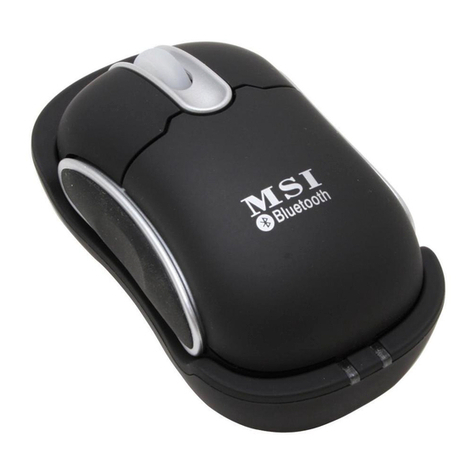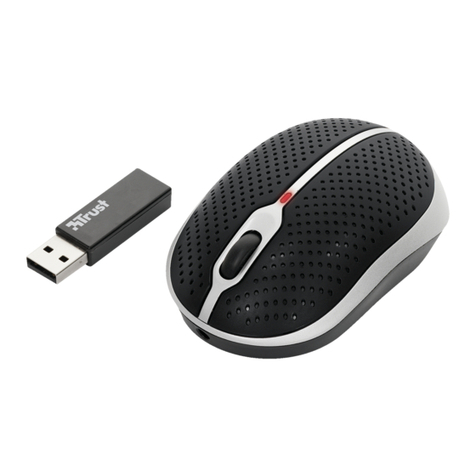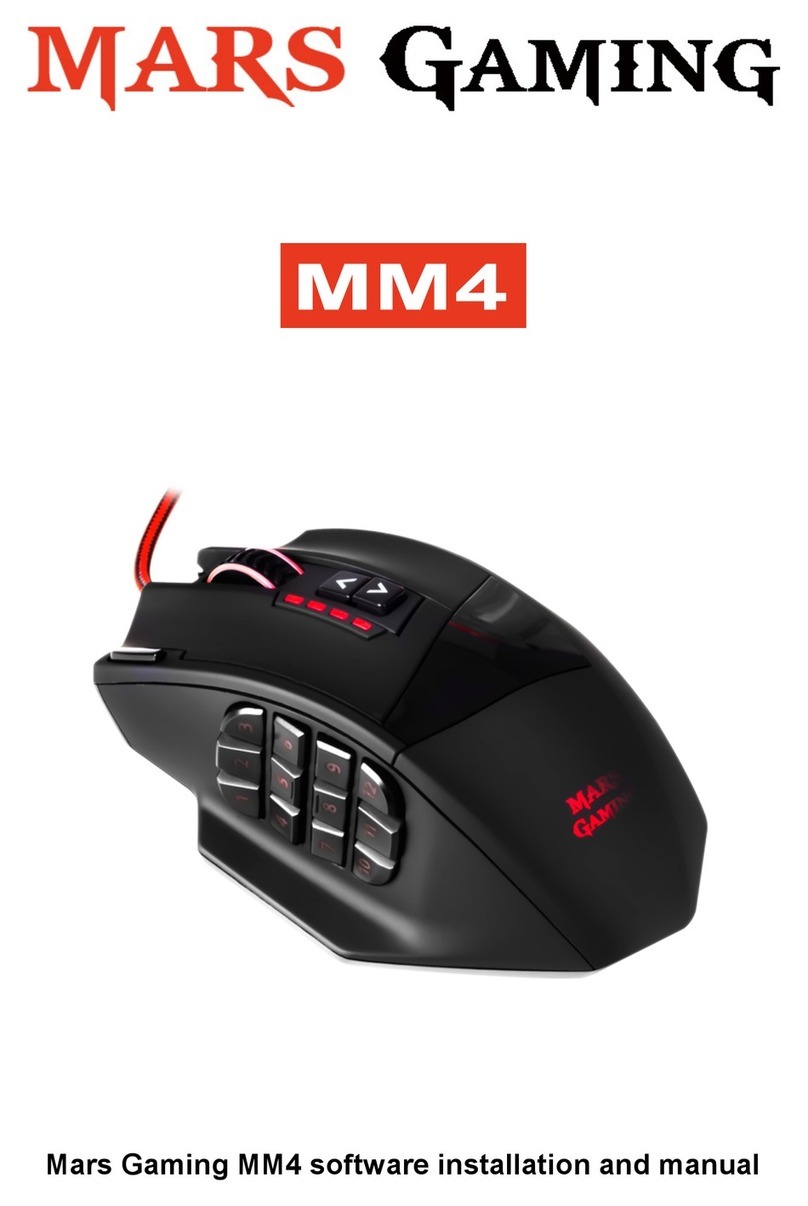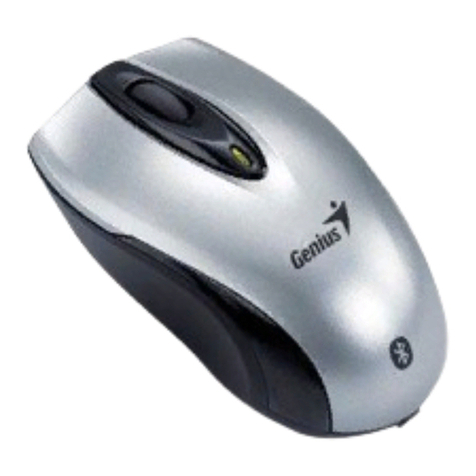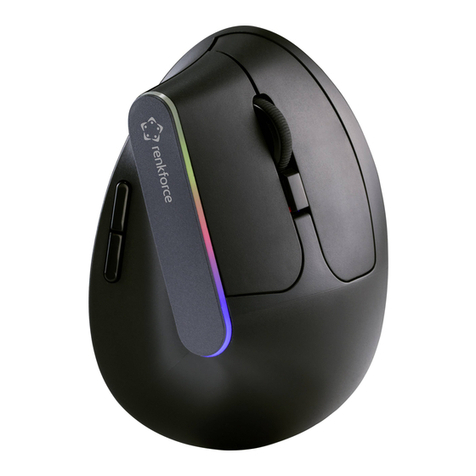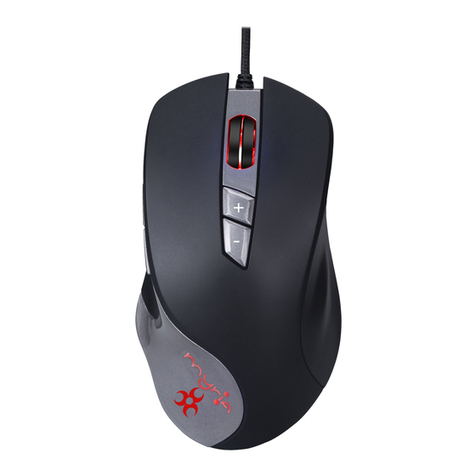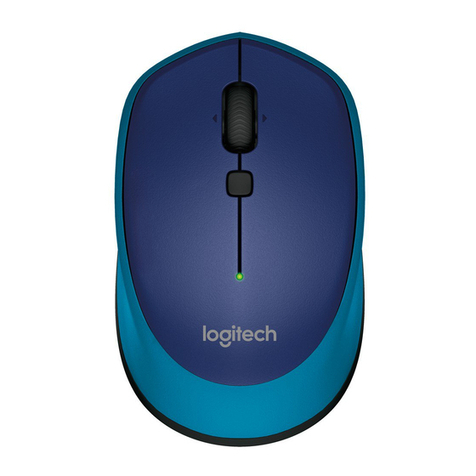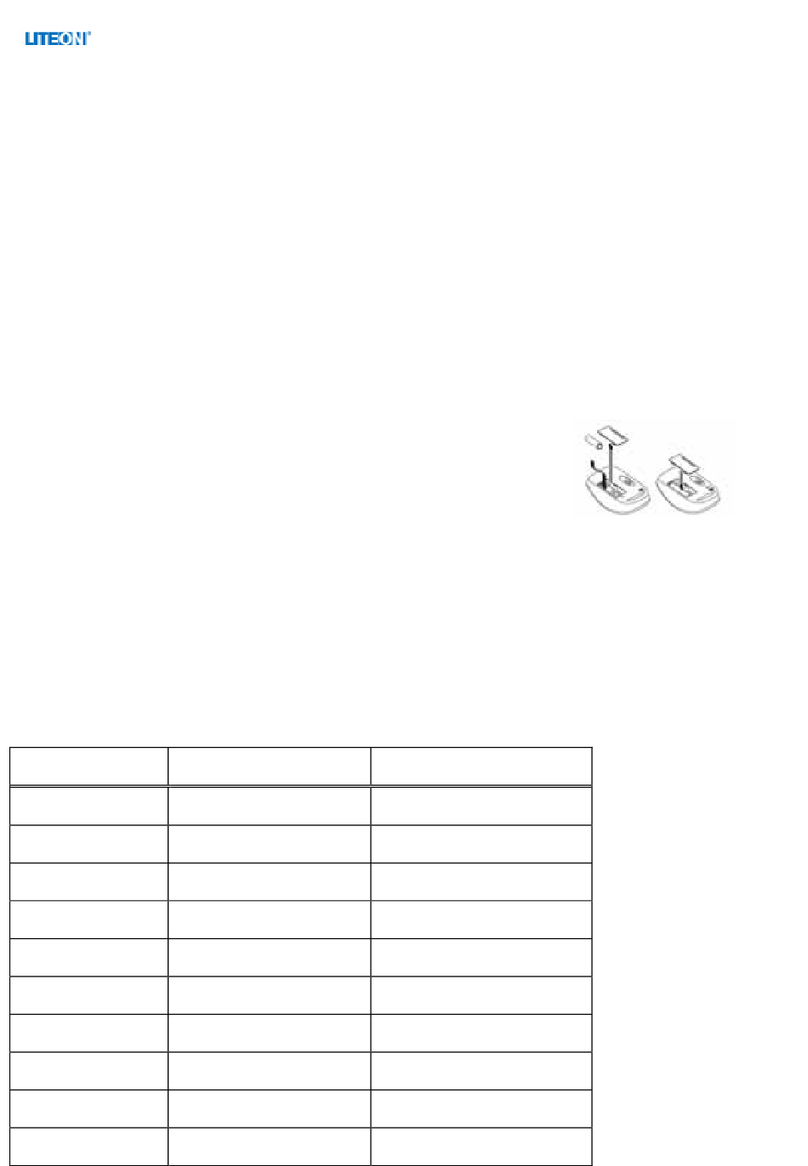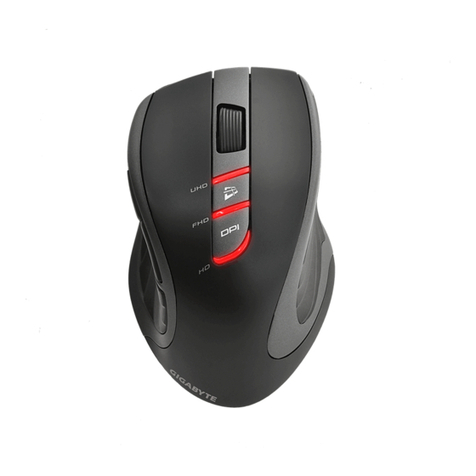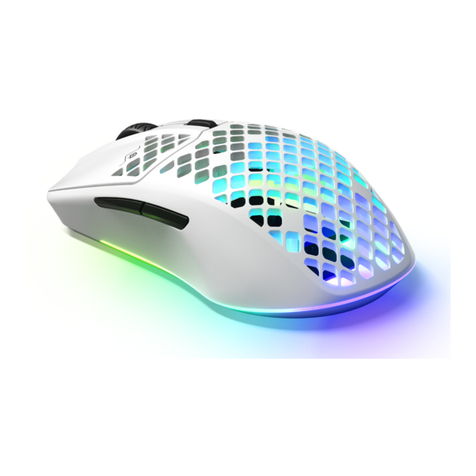MSI AY3 User manual

Gaming Mouse
OWNER'S GUIDE
Ver.:1.00
CAUTION: To use this product properly, please read the user's guide before installing.

1
Federal Communication Commission Interference Statement
This equipment has been tested and found to comply with the limits for a
Class B digital device, pursuant to Part 15 of the FCC Rules. These limits
are designed to provide reasonable protection against harmful interference
in a residential installation. This equipment generates, uses and can radiate
radio frequency energy and, if not installed and used in accordance with the
instructions, may cause harmful interference to radio communications.
However, there is no guarantee that interference will not occur in a
particular installation. If this equipment does cause harmful interference to
radio or television reception, which can be determined by turning the
equipment off and on, the user is encouraged to try to correct the
interference by one of the following measures:
- Reorient or relocate the receiving antenna.
- Increase the separation between the equipment and receiver.
- Connect the equipment into an outlet on a circuit different from
that to which the receiver is connected.
- Consult the dealer or an experienced radio/TV technician for help.
FCC Caution: Any changes or modifications not expressly approved by the
party responsible for compliance could void the user's authority to operate
this equipment.
This device complies with Part 15 of the FCC Rules. Operation is subject to
the following two conditions: (1) This device may not cause harmful
interference, and (2) this device must accept any interference received,
including interference that may cause undesired operation.

2
Mouse Buttons
1. Left button (Click) 6. CPI up
2. Right button (Menu) 7. CPI down
3. Scrolling Wheel 8. Scroll up
4. Forward 9. Scroll down
5. Backward .
Backward
Press this button to view the pervious page of the Internet browser.
Forward
Press this button to view the next page of the Internet browser.
For USB port installation
1. Plug the USB connector to the USB port of your computer
2. The computer will detect and install the mouse automatically
3. When the installation completes, the mouse is ready to use

3
System Requirements
Windows® XP/Vista/7/8/8.1
Free USB port
CD-ROM driver
25MB free hard disk space
Installation
Step 1: Plug the mouse into any free USB port on your computer.
Step 2: Windows® will automatically detect the gaming mouse.
Step 3: Start the installation process by clicking on the file “Setup.exe”
Step 4: Windows® will prompt you if installation should continue despite
not passing Windows logo testing; install the driver despite this.
Note:The driver will automatically uninstall older driver versions. For that
reason it may take a little while until the driver is installed and ready to use
then repeat step3.
Step 5: Select language
Step 6: As soon as the installation process has completed click ‘OK’.
Step 7: Reboot your PC.
Step 8: The symbol will now appear in the right-hand side of the
Taskbar. You access the gaming mouse configuration menu by right
clicking it.

4
Switch Orientation
Right-handed:The right hand is suitable
Left-handed:The left hand is suitable
Mode Switch
Advanced setting allows setting two button setting and use mode switch
button to switch between Mode1 & Mode2.

5
Programmable Keys
Click: Left mouse button.
Menu: Right mouse button. The context menu will open when you point to a
document or folder using the mouse.
Universal scrolling: Mouse wheel function to scroll by
moving the mouse.
Double-click: Left mouse button double click.
Assign a shortcut: A single keyboard command can be assigned to
one of the mouse buttons.
Button off : Switches the button function off.
IE Forward: Select the next previously selected program or internet site.
IE Backward: Select the previous program or website
Scroll up: Scroll up the page you are currently viewing
Scroll down: Scroll down the page you are currently viewing
Click Menu Universal Scrolling Double Click
Assign a shortcut Button off IE Forward IE Backward
Scroll up Scroll down Tilt Left Tilt Right
Assign a launch Fire button On-To-Go Windows Key
Open Driver Mode Switch

6
Tilt Left: Scroll horizontally to the left (only under Windows Vista™/ 7 / 8 / 8.1).
Tilt Right: Scroll horizontally to the right (only under Windows Vista™/ 7 / 8 / 8.1).
Assign a launch: Assign a launch program
Fire button: Left button twice click function
On-To-Go: The “On-To-Go” button click function: Hold pressed the
“On-To-Go” button and combined with any button pressing,
then this button click function will continue to auto-repeat
working.
Windows Key: Windows system key
Open Driver: Open the gaming mouse AP
Mode Switch: Mode1:CPI Led light on the top flash 5 sec then off
Mode2:CPI Led light on the end flash 5 sec then off
Create/Save Profile
Create one of five profiles. For instance, you can save all button
assignments, macros, color settings or sensitivity settings to a profile here.
As each different mouse assignment is best suited to different programs
you can assign each program/game a special preset.
Note:Along with the left and right mouse buttons the mouse has 7 additional
buttons which can be freely assigned with the functions available in the driver
menu. You’ll see the list of functions that can be assigned when you click on
the dropdown menu to the side of the particular button.

7
Once you’ve assigned all desired macros using the macro manager to
different buttons, and perhaps made different color setting changes, save
these. It’s best to name the profile after the program or game for which
you’ve configured the settings.
You can then also link it to the
*.exe file of the program or
game by entering the relevant
path when saving the profile.
By linking a program to a
profile, the mouse will
Automatically switch to the
relevant profile upon starting
the respective game or
program.

8
Load Profile
You can save your five ready-to-play profiles that you’ve downloaded or
created in game. It is an easy way to share the profile with your friend as
well.
Edit Profile
Here you can edit the names and the link of the selected profile. Use the
link so that the mouse automatically detects the program you’ve
programmed specific mouse settings or macros for.
Assign Macro Macro Manager
Multimedia Open player Pre Track Next Track
Play/Pause Stop Mute
Volume Up Volume Down Select Player
Profile switch Profile cycle Profile up Profile down
CPI Switch CPI cycle CPI up CPI down
Windows Calculator Email WWW Favorites
WWW Forward WWW Back WWW Stop
My Computer WWW Refresh WWW Home
WWW Search

9
Assign Macro
MACRO MANAGER
Creating a Macro
(Basic Editor)
Step 1 :
you can add a macro set by pressing
New or delete one by pressing Delete.
Step 2:
If you click ‘New’ on the left hand
window, you can assign a name to
the macro like ‘Arcane rotation’ or
‘Sniper rifle’, Confirm the name by
hittingthereturn/enterkey.
Step 3:
Now you can enter a macro. To do
that, Click the ‘Start Record’ button in
the right-hand window. Enter the key
Combination which you need for a
special action in the game. The option
‘Record delays between key commands’
is located under the record button.
This option allows you to determine
how long a certain key should be
pressed for. As a result it’s possible
to create a macro that instructs a
figure in the game to only perform
a specific action after a
pre-determined period.

10
Step 4:
Click ‘Stop Record’ once you’re done
entering your key combination via the
keyboard. You can now either record
an additional macro in the macro set
you’ve created or create new macro
set. Click ‘OK’ when you’re done.
The macro can now be assigned to any
one of the six programmable buttons.
You can assign the macro to a button
by clicking onto the arrow next to the
box of the button you want the macro
to be assigned to. In the following
dropdown menu choose ’Assign Macro’.
All available macro sets are now
displayed. Select the one containing
your macro of choice and then click
on the respective macro.
Note:if you’ve edited a macro that is
already assigned to a particular button.
You’ll need to assign the macro to the
desired mouse button again.

11
Step 5:
Assign the function to the mouse by
clicking the ‘Apply’ Button without
exiting the menu .It may take a few
seconds until the information is
transferred to the mouse. You can
now store and save these settings
under one of the five profiles that can
be stored on the mouse. Profiles will
be easier to manage if you name them
after the game, gamer or program.
Integrate Mouse Clicks
Another special feature of the driver is that it allows you to integrate
mouse clicks into a macro along with keyboard commands. You can
program a mouse event to be executed after, before or in-between a
key sequence.
To do that, select the keyboard command in the ‘Macro Manager’ before or
after which you want to insert a new event.
By right clicking, you can open a window that contains various options:
Note:A running macro can be
ended at any time by clicking on
the button again.

12
Start Record Before: Starts recording the macro before the selected event.
Start Record After: Starts recording the macro after the selected event.
Insert Delay:
Manually increase or decrease the delay between two Commands.
Insert Mouse Event:
Specify which mouse event should be executed. The following options are
available:

13
Left Button: Left mouse button
Right Button: Right mouse button
Wheel: Centre mouse wheel button
Forward: next previously selected program button
Backward: previous program button
There are always three events to choose from:
Down: Keeps the button depressed
UP: Releases the button
Click: Executes the commands ‘press’ and ‘release’ in turn.
Edit Delay:
You can manually increase or decrease the delay Here. All you need to do
is enter the desired time Value; there’s no need to enter ‘ms’(milliseconds).
Delete:
Delete the selected step from the macro’s key sequence.
Note: The mouse scroll function
of the mouse wheel is not
possible to be program. Here too,
only three Options are available;
‘press’. ‘release’ as well as ‘press
and release’.
Note: Some games are unable to
detect short delays.

14
Multimedia
Open player: Start media player
Pre Track: Switch to the previous media track
Next Track: Switch to the next media track
Play/Pause: Switch between playing and pausing media
Stop:Stop playing the media in the media player
Mute: Mute (turns off) the computer's sound
Volume Up: Increase the computer's sound volume.
Volume Down: Decrease the computer's sound volume.
Select Player:Arrange default media player software.
Profile switch
Profile cycle: cycle switch
Profile up: Reverse cycle switch
Profile down: Positive cycle switch
CPI Switch
CPI Cycle: cycle switch(Default 800→3200→6400→800→3200)。
CPI Up:Reverse cycle switch(Default 800→3200→6400)。
CPI Down:Positive cycle switch(Default 800→6400→3200)。
Windows
Calculator: Start Microsoft Calculator
Email: Start the default e-mail program
WWW Favorites: Open the Internet Explorer Favorites
WWW Forward: Select the next internet site
WWW Back: Select the previous website
WWW Stop: Web Stop
My Computer: Open My Computer
WWW Refresh: Refresh the current Web page
WWW Home: Start the default Web browser and loads the home Web page
WWW Search: Open the Internet Explorer Search panel
Note:Mouse include memory , can
save five game profile setting (not
include Macro key record )
Use one functionkey to switch the
profile Profile change.
Profile light : All the LED flash 5 sec
and back to activate status.

15
SENSITIVITY
Sensitivity options
Adjust the overall moving sensitivity
of the mouse sensor.
Select a moving sensitivity level on
a scale of -90%~+100%.
CPI Switcher
Select the desired resolution(s) of the
mouse sensor here.
The arrow beneath the number bar
shows which dpi value is currently
active. we recommend using the
mouse with a resolution of 800dpi at first then increasing the dpi resolution
in steps as soon as you become accustomed to the speed.
CPI setting
.Default CPI switch between 800/3200/6400, default setting is CPI 800
.These CPI settings are also easily adjustable if you want to personalize
your settings From 400 – 6400。
.Customizable CPI setting ,use CPI function key to switch 。
CPI display
.First(Default 800)LED on the top flash 5 sec then off ,second Led off
.Second(Default 3200)LED on the top off, second LED flash 5 sec then
off
.Third(Default 6400)Both LED flash 5 sec then off.

16
ADVANCED SETTING
Polling Rate:
The term ‘polling rate’ describes the
Number of times the computer
prompts the mouse for information.
A high polling rate in conjunction with
a high dpi setting ensures smooth
pointer movement. We recommend
that you start off with a resolution of
800dpi and a polling rate of 1000Hz.
Light effect switch
Set up Light LED ON/OFF
Light effect type options
Set up Light LED Full lightened or breathing
Driver Reset
By clicking the RESET button, all the settings you
have made will be reset to their original factory
default settings.
ON-TO-GO SPEED
Enable to set up click delay time between 2 to 255MS
Note: In general a high polling rate
produces a rounder and softer
p
ointer movement.

17
SYSTEM SETTING
Double Click
Configure the double-click response
speed here. Closer to 1 means the
interval between two mouse clicks is
long. closer to 11 means that the
interval between clicks is particularly
short.
Windows Pointer Speed
Set the speed of the mouse pointer
on a scale of 1 to 11 here. This is the
same as the value that has been set
in the Windows Control Panel.
Note:Please note that all settings must
be Transferred to the mouse by clicking
the ‘Appl
y
’ button.
Note:Standard recommends to keep
the default settin
g
s

18
OSD SETTING
A vary of information can be displayed with On Screen Display function
bases on user selection.
the contents which is selected in the AP software are shown in the OSD a
minimum set of modules for the OSD is provided as part of the AP software:
CPU & RAM、Profile status、Macro execute status、New email、Skype、
Msn.
On screen display
CPU Loading
CPU Loading status
RAM Loading
RAM Loading status
Profile Status
When profile is change by the
profile button or key, and
Driver/AP automated showing
OSD profile status panel.
Macro execute status
When any macro button or
key is pressed by the user,
and Driver/AP automated
showing the panel of OSD
Macro execute status.
New Email
New email notice
Skype
Instant message notice
CPI Status
CPI status
MSN Status
Msn status

19
Color select
OSD Windows Colors: Here are Red、Orange、Yel low、Blue、Cyan、
Purple, six colors for your options.
Transparency
OSD transparency is adjustable from 10% to 100%.
Email / POP3 setting
Mail Server (POP3)
Set up your external mail server
Port Number
Set up your port number.
User Name
Set up your user name.
Password
Set up your password.
Check interval Set up the new mail notice.
Table of contents
Other MSI Mouse manuals
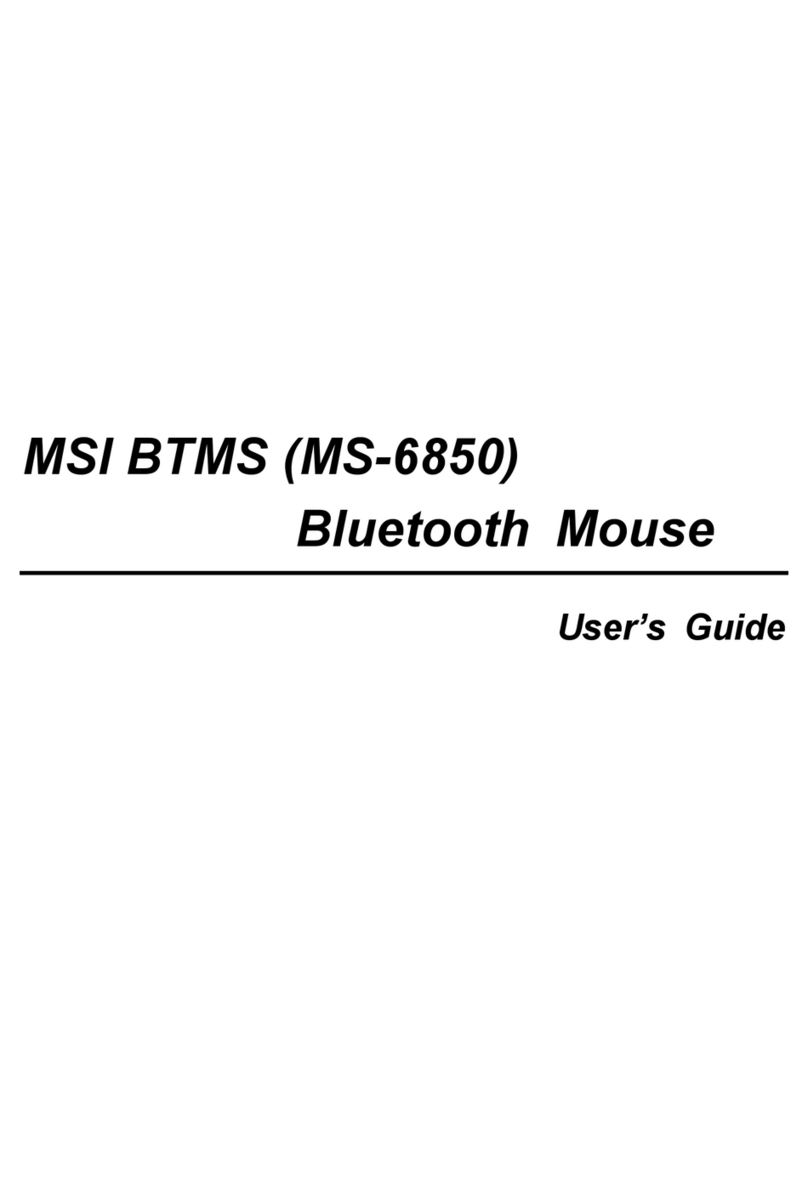
MSI
MSI MS-6850 User manual

MSI
MSI BM500 User manual

MSI
MSI Star Mouse SW-101 User manual

MSI
MSI Star Mouse BM100 Manual
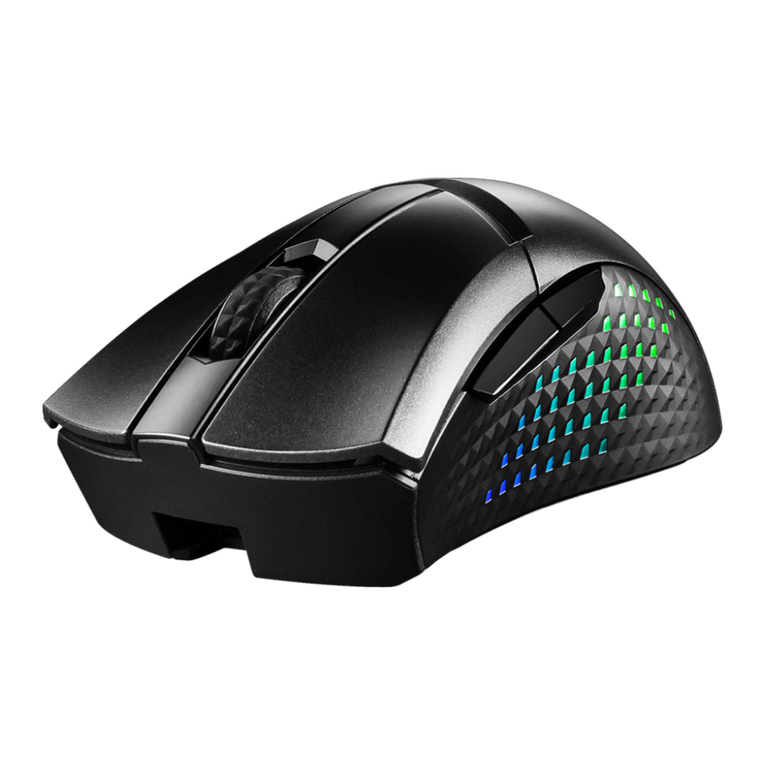
MSI
MSI CLUTCH GM51 LIGHTWEIGHT WIRELESS User manual
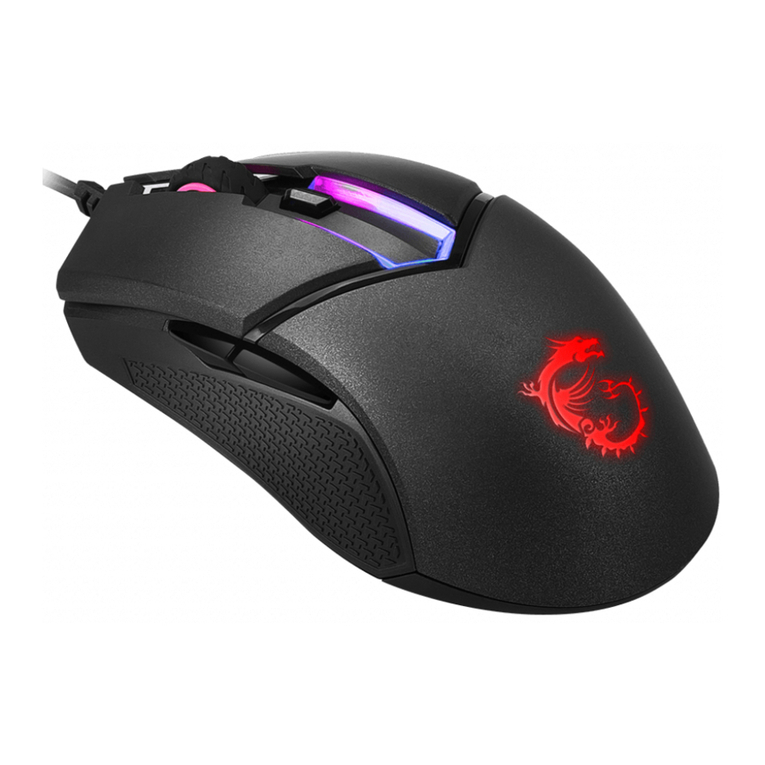
MSI
MSI CLUTCH GM30 User manual
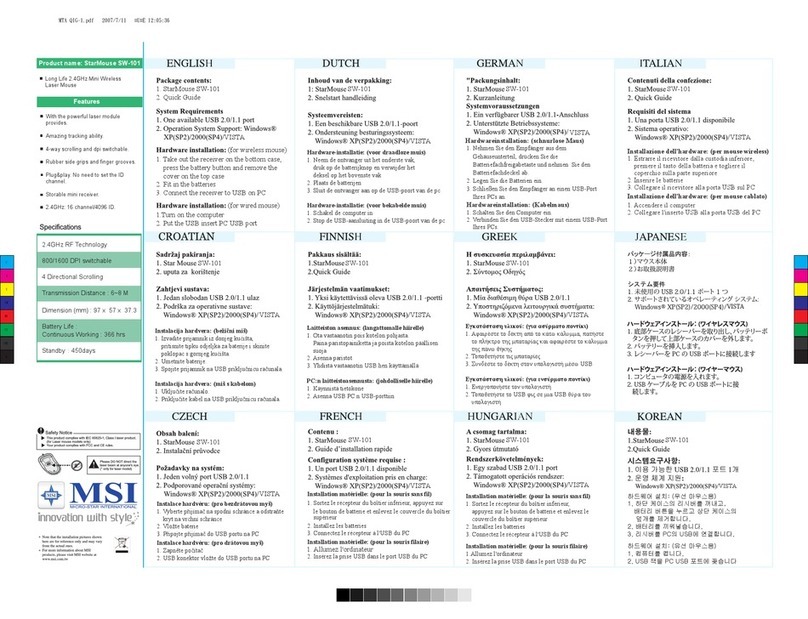
MSI
MSI Star Mouse SW-101 User manual
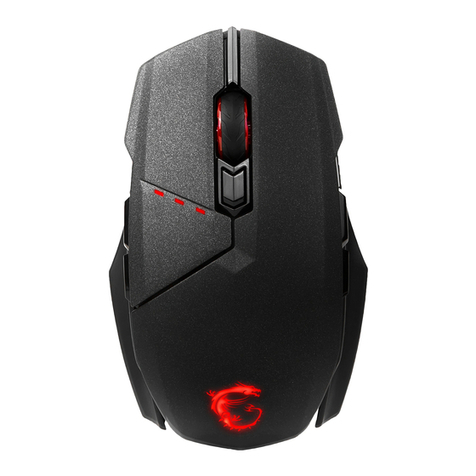
MSI
MSI GM70 User manual
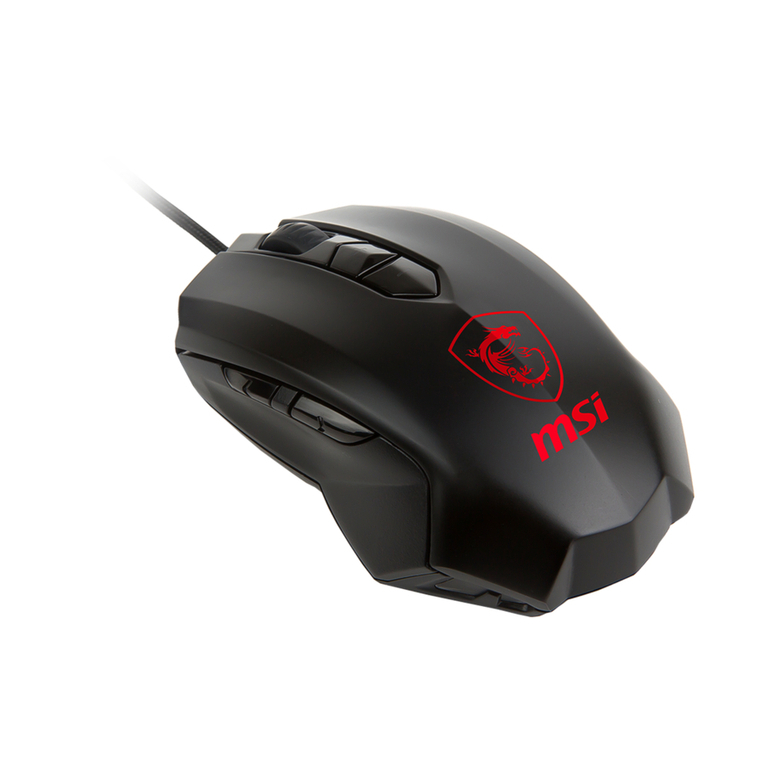
MSI
MSI GAMING MOUSE 2017 User manual

MSI
MSI Clutch GM40 User manual



